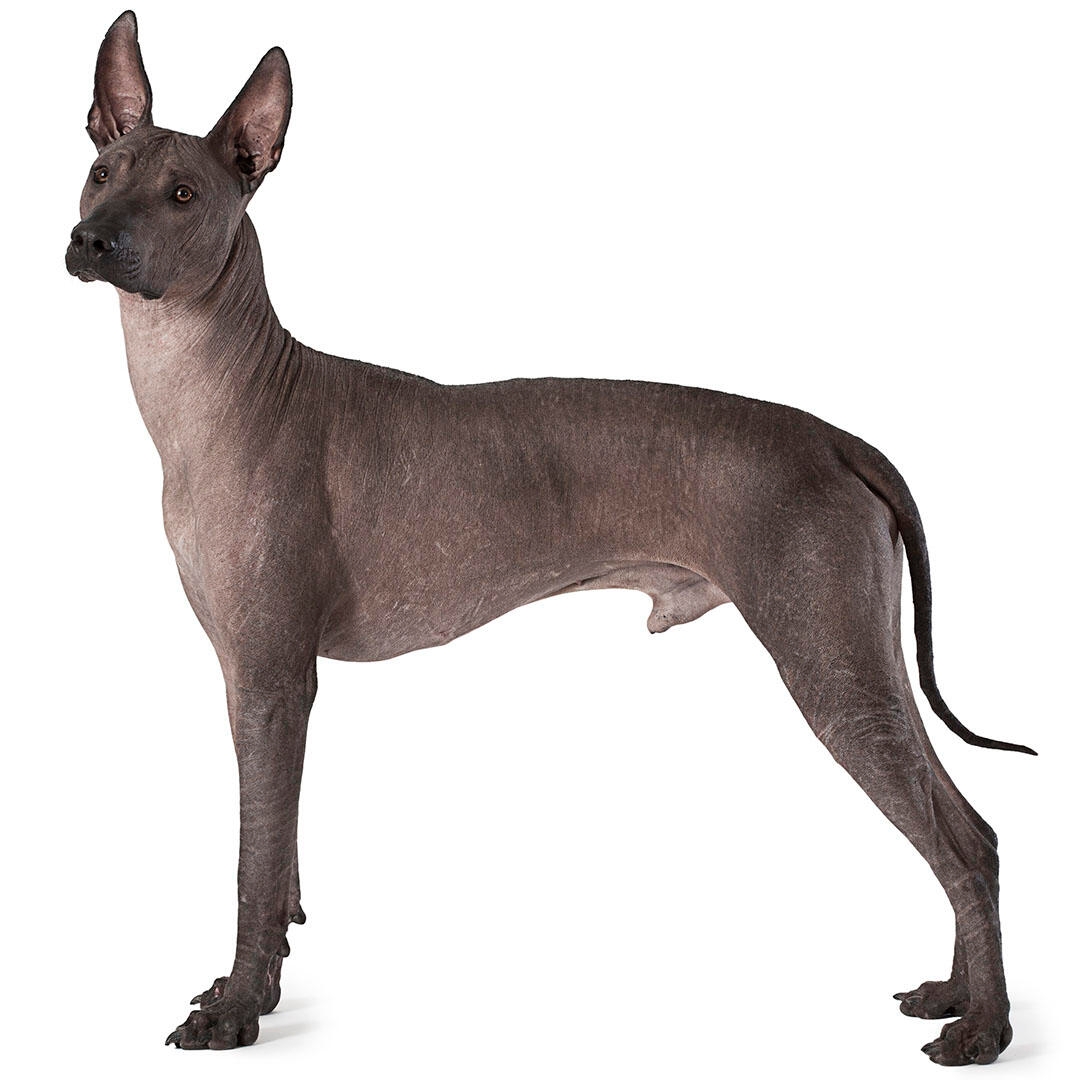
| Family-friendly: | 5/5 |
| Exercise needs: | 3/5 |
| Easy to train: | 3/5 |
| Tolerates being alone: | 2/5 |
| Likes other pets: | 2/5 |
| Energy level: | 3/5 |
| Grooming needs: | 3/5 |
| Shedding: | 1/5 |
The main health problems encountered in the Mexican Hairless dog are related to their skin, being particularly predisposed to sunburn given the lack of protection from fur.
Priority Kennel Club health schemes and testing:
None but there are several recommended schemes that the Kennel Club recommends which can be found here.
Shy and reserved with strangers, the Mexican Hairless Dog is in fact an intelligent, loving companion with family. Described as peaceful and contented, they are alert to their environment and will bark to alert their owners to the presence of strangers or unusual activity. As may be expected, they are warm and cuddly and will appreciate a warm jumper or coat in cooler weather, and can be found burrowed under blankets or your duvet when temperatures drop.
| Family-friendly: | 5/5 |
| Exercise needs: | 3/5 |
| Easy to train: | 3/5 |
| Tolerates being alone: | 2/5 |
| Likes other pets: | 2/5 |
| Energy level: | 3/5 |
| Grooming needs: | 3/5 |
| Shedding: | 1/5 |
Thought to be an ancient breed, the Mexican Hairless or Xolo has been associated with the peoples of Central and South America for around 3000 years. Revered by the Aztecs, the name Xoloitzcuintle (say ‘sholo-eats-QUEENT-ly’) means ‘dog god’ (or ‘dog of the god Xolotl’ who was the god of deformed things, and a hairless dog seemed to fulfil that description). They were thought to have special powers of healing transmitted to them from the gods. They were also used as a gift to the gods and were sacrificed and eaten.
Fortunately their unusual appearance and calm, dignified personality meant sufficient of the breed survived to leave Mexico when dog showing became a popular hobby. First shown as early as 1883, the breed was recognised by the American Kennel Club but was so rare they were removed from the register of recognised breeds in 1959. They rose again in popularity in the 1980s but are still not fully recognised by the Kennel Club, though are now on the import register so should soon reach full recognition in the UK.
Ideal Xolo owners are experienced and able to give plenty of training, active walks, careful socialisation and simple dog grooming combined with specialist skin care. They are devoted and very attentive to their owners and will act as a watchdog – so you should be at home most of the time and not have close neighbours. On top of this, you need the patience for endless conversations about why your dog is naked, and how on earth do you pronounce Xoloitzcuintle, and being stopped for photographs with your unusual looking hound!
Miniature Mexican Hairless dogs need about half an hour of daily dog exercise and the Intermediate and Standard need about an hour. Ensure whichever size you have has plenty of mental exercise in the form of training and puzzle solving games and activities. Do ensure they are protected from the elements (both the warm and cold) before taking them outside.
The Mexican Hairless does not need a large home, however they will appreciate a warm and comfortable house, soft bedding and need a very secure garden as they are excellent climbers, agile jumpers and generally clever escape artists! Country or town as long as they have plenty of exercise both mental and physical, they will be happy.
The Miniature Mexican Hairless dog is a small dog that has a fast metabolism, meaning they burn energy at a high rate, although their small stomachs mean that they must eat little and often. Small-breed foods are specifically designed with appropriate levels of key nutrients and smaller kibble sizes to suit smaller mouths. This also encourages chewing and improves digestion.
The Intermediate and Standard diets need to have the right balance of all the main nutrient groups including a constant supply of fresh water. It's also important to conduct regular body condition scores to ensure you keep your dog in ideal shape and remember to feed him at least twice daily and in accordance with the feeding guidelines of his particular food.
Discover more about how to offer your dog a balanced diet with our easy-to-follow guide.
Small tufts of hair can appear on the Mexican Hairless dog, but this is a generally hairless dog and no hair-care is therefore required. However, the skin can become dry, as it is not protected with a coat. Smoothing some baby oil on will help hydrate the skin. A suitable sun cream can be used to prevent the skin from burning, and the dogs should be kept out of direct sunlight in warm weather. The dogs also need protection against the cold and should wear a coat when walked in the winter months.
Intelligent and quick to learn, the Mexican Hairless needs careful dog socialisation due to their naturally wary, reserved nature. Capable of high levels of dog training if this is done sensitively using positive reinforcement-based methods. All sizes of Mexican Hairless will benefit from basic training and in particular a good recall and training to ignore livestock or small furries, as they will hunt and chase.
A good family dog for those with older children or teenagers, puppies can be rather boisterous, loud and can play bite enthusiastically so may not suit homes with very small children.
While many dogs are traditionally thought of as being good with children, all dogs and children need to be taught to get on with each other and be safe together. Even so, dogs and young children should never be left alone together and adults should supervise all interactions between them.